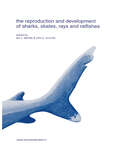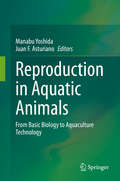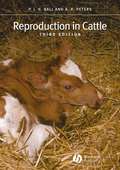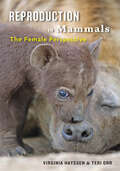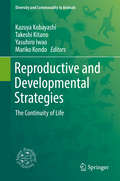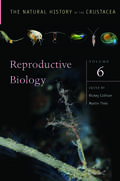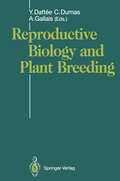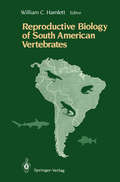- Table View
- List View
Reproduction and Development in Echinodermata and Prochordata (Reproduction and Development in Aquatic Invertebrates)
by T. J. PandianEchinoderms and prochordates occupy a key position in vertebrate evolution. The genomes of sea urchin share 70% homology with humans. Researches on cell cycle in sea urchin and phagocytosis in asteroids have fetched Nobel Prizes. In this context, this book assumes immense importance. Echinoderms are unique, as their symmetry is bilateral in larvae but pentamerous radial in adults. The latter has eliminated the development of an anterior head and bilateral appendages. Further, the obligate need to face the substratum for locomotion and acquisition of food has eliminated their planktonic and nektonic existence. Egg size, a decisive factor in recruitment, increases with decreasing depths up to 2,000-5,000 m in lecithotrophic asteroids and ophiuroids but remains constant in their planktotrophics. Smaller ( 110 mm) asteroids generate planktotrophic eggs only. Publications on sex ratio of echinoderms indicate the genetic determination of sex at fertilization but those on hybridization, karyotype and ploidy induction do not provide evidence for heterogametism. But the herbivorous echinoids and larvacea with their gonads harboring both germ cells and Nutritive Phagocytes (NPs) have economized the transportation and hormonal costs on gonadal function. Despite the amazing potential just 2 and 3% of echinoderms undergo clonal reproduction and regeneration, respectively. Fission is triggered, when adequate reserve nutrients are accumulated. It is the most prevalent mode of clonal reproduction in holothuroids, asteroids and ophiuroids. However, budding is a more prevalent mode of clonal reproduction in colonial hemichordates and urochordates. In echinoderms, fission and budding eliminate each other. Similarly, autoregulation of early development eliminates clonal reproduction in echinoids and solitary urochordates. In pterobranchs, thaliaceans and ascidians, the repeated and rapid budding leads to colonial formation. Coloniality imposes reductions in species number and body size, generation time and life span, gonad number and fecundity as well as switching from gonochorism to simultaneous hermaphorditism and oviparity to ovoviviparity/viviparity.
Reproduction and Development in Minor Phyla (Reproduction and Development in Aquatic Invertebrates)
by T. J. PandianThe 26 recognized minor phyla comprise aberrant clades, as most of them terminate as blind offshoots. Untied from the discussion on their phylogenesis of minor phyla, this book is largely devoted, for the first time, to aspects of reproduction and development in minor phyletics. The minor phyla are not as speciose (1,795 species/phylum) as the major phyla (157,066 species/phylum) are. The accumulation of deleterious genes causes inbreeding depression among progenies arising from parthenogenesis, clonal multiplication and selfing hermaphrodites. The reason for the limited species diversity in minor phyla is traced to (i) eutelism in 65.7% of minor phyletics and (ii) existence of 21.6% clonals, (iii) 6.4% parthenogens and (iv) 1.2% selfing hermaphroditism. Gonochorism obligately requires motility to search for a mate. The combination of low motility and gonochorism from Placozoa to hemocoelomatic minor phyla has limited diversity to
Reproduction and Development in Minor Phyla (Reproduction and Development in Aquatic Invertebrates)
by T. J. PandianThe 26 recognized minor phyla comprise aberrant clades, as most of them terminate as blind offshoots. Untied from the discussion on their phylogenesis of minor phyla, this book is largely devoted, for the first time, to aspects of reproduction and development in minor phyletics. The minor phyla are not as speciose (1,795 species/phylum) as the major phyla (157,066 species/phylum) are. The accumulation of deleterious genes causes inbreeding depression among progenies arising from parthenogenesis, clonal multiplication and selfing hermaphrodites. The reason for the limited species diversity in minor phyla is traced to (i) eutelism in 65.7% of minor phyletics and (ii) existence of 21.6% clonals, (iii) 6.4% parthenogens and (iv) 1.2% selfing hermaphroditism. Gonochorism obligately requires motility to search for a mate. The combination of low motility and gonochorism from Placozoa to hemocoelomatic minor phyla has limited diversity to
Reproduction and Development in Mollusca (Reproduction and Development in Aquatic Invertebrates #2)
by T. J. PandianThis book is perhaps the first attempt to comprehensively project the uniqueness of molluscs, covering almost all aspects of reproduction and development from aplacophorans to vampyromorphic cephalopods. Molluscs are unique for the presence of protective external shell, defensive inking, geographic distribution from the depth of 9,050 m to an altitude of 4,300 m, gamete diversity, the use of nurse eggs and embryos to accelerate the first few mitotic divisions in embryos, the natural occurrence of androgenics in a couple of bivalves, viable induced tetraploids, gigantism induced by elevated ploidy, the complementary role played by mitochondrial genome in sex determination by nuclear genes and the uptake and accumulation of steroid hormone from surrounding waters. In molluscs, sexuality comprises of gonochorism ( 24%), protandry (
Reproduction and Development in Mollusca (Reproduction and Development in Aquatic Invertebrates)
by T. J. PandianThis book is perhaps the first attempt to comprehensively project the uniqueness of molluscs, covering almost all aspects of reproduction and development from aplacophorans to vampyromorphic cephalopods. Molluscs are unique for the presence of protective external shell, defensive inking, geographic distribution from the depth of 9,050 m to an altitude of 4,300 m, gamete diversity, the use of nurse eggs and embryos to accelerate the first few mitotic divisions in embryos, the natural occurrence of androgenics in a couple of bivalves, viable induced tetraploids, gigantism induced by elevated ploidy, the complementary role played by mitochondrial genome in sex determination by nuclear genes and the uptake and accumulation of steroid hormone from surrounding waters. In molluscs, sexuality comprises of gonochorism ( 24%), protandry (
The reproduction and development of sharks, skates, rays and ratfishes (Developments in Environmental Biology of Fishes #14)
by John P. Wourms Leo S. DemskiThis volume had its origin in a symposium on the Reproduction and Development of Cartilaginous Fishes that was held at the annual meetings of the American Elasmobranch Society and the American Society of Ichthyologists and Herpetologists in Charleston, South Carolina in 1990. The cartilaginous fishes, class Chondrichthyes, are a large and diverse group of fishes that include approximately 900 to 1100 living species of sharks, skates, rays and ratfishes. Throughout their history, which dates back at least 400 million years, they have been a successful major component of the marine ecosystem. The chondrichthyan fishes occupy a pivotal position in comparative and evolutionary studies of vertebrate reproduction and development. They are the oldest surviving group of jawed vertebrates and they possess both the adult vertebrate Bauplan and the vertebrate program of embryonic development. The major features of the female reproductive system, including its embryonic origin, structure, physiological function, and biochemistry, apparently were established early in vertebrate evolution and are fully developed in chondrichthyan fishes. These features of the female reproductive system have been retained during the evolution of the other classes of vertebrates. Much the same can be said for the male reproductive system. Moreover, viviparity, placental nourishment of developing embryos, and the hormonal regulation of these events made an initial appearance in this group. The 22 articles presented in this volume bring together a wide variety of complementary research by investigators from seven countries, allowing us to broaden the scope and implications of our studies while identifying opportunities for future research. The appearance of a volume on the reproduction and development of cartilaginous fishes is quite opportune. The continued existence of these fishes, which survived the great extinction events of Earth's history, is now threatened by overexploitation unless immediate steps for their conservation are undertaken. Knowledge of their reproduction and development not only is an end in itself, but is of critical importance in devising successful conservation and resource management strategies.
Reproduction and Fitness in Baboons: Behavioral, Ecological, and Life History Perspectives (Developments in Primatology: Progress and Prospects)
by Larissa Swedell Steven R. LeighThis volume brings together current research on the behavior, ecology, reproduction, and life history of baboons of the genus Papio, shedding light on what makes baboons successful. The book focuses on issues such as infanticide, mating strategies and investment, hybridization and genetics. The findings have broad applications to understanding the evolution of complex life history adaptations in other primates, and of humans in particular.
Reproduction in Aquatic Animals: From Basic Biology to Aquaculture Technology
by Manabu Yoshida Juan F. AsturianoThis book provides an up-to-date overview of the various reproductive systems of a variety of aquatic animals, from invertebrates to fishes. While all terrestrial animals use internal fertilization, aquatic animals have diverse reproductive systems. Some are internal fertilizers with or without mating, but many perform external fertilization. Because of this diversity, the reproductive systems of aquatic animals represent excellent models for the study of adaptive evolution and the species specificity of fertilization. In addition, many aquatic animals, including fish, crustaceans, and mollusks, are important as fishery and aquaculture resources. In this book, up-and-coming researchers examine reproductive systems in representative aquatic animals, covering both the basic knowledge and late-breaking results. Reproduction in Aquatic Animals: From Basic Biology to Aquaculture Technology will be of interest to graduate and postgraduate students in biology and agricultural sciences, as well as to researchers and technicians in the fields of reproductive biology and fishery science and to non-academics.
Reproduction in Cattle
by Peter J. Ball Andy R. PetersCattle play a fundamental role in animal agriculture throughout the world. They not only provide us with a vital food source, but they also provide us with fertilizer and fuel. Keeping reproduction levels at an optimum level is therefore essential, but this is often a complicated process, especially with modern, high yielding cows. Written in a practical and user-friendly style, this book aims to help the reader understand cattle reproduction by explaining the underlying physiology of the reproductive process and the role and importance of pharmacology and technology, and showing how management techniques can improve reproductive efficiency. This edition includes: Recent research findings on the physiology of the oestrous cycle and its control; New techniques for monitoring and manipulating reproduction, including pregnancy diagnosis and embryo transfer; Advice on identifying common infertility problems and how to prevent and treat them. Reproduction Cattle 3e is essential reading for veterinary and agricultural students, as well as veterinarians and farmers involved in cattle reproduction.
Reproduction in Farm Animals
by B. Hafez E.S.E. HafezWhen you’re looking for a comprehensive and reliable text on large animal reproduction, look no further! the seventh edition of this classic text is geared for the undergraduate student in Agricultural Sciences and Veterinary Medicine. In response to reader feedback, Dr. Hafez has streamlined and edited the entire text to remove all repetitious and nonessential material. That means you'll learn more in fewer pages. Plus the seventh editing is filled with features that help you grasp the concepts of reproduction in farm animals so you'll perform better on exams and in practice: condensed and simplified tables, so they're easier to consult an easy-to-scan glossary at the end of the book an expanded appendix, which includes graphic illustrations of assisted reproduction technology Plus, you'll find valuable NEW COVERAGE on all these topics: Equine Reproduction: expanded information reflecting today's knowledge Llamas (NEW CHAPTER) Micromanipulation of Gametes and In Vitro Fertilization (NEW CHAPTER!) Reach for the text that's revised with the undergraduate in mind: the seventh edition of Hafez's Reproduction in Farm Animals.
Reproduction in Farm Animals
by E. S. E. Hafez B. HafezWhen you’re looking for a comprehensive and reliable text on large animal reproduction, look no further! the seventh edition of this classic text is geared for the undergraduate student in Agricultural Sciences and Veterinary Medicine. In response to reader feedback, Dr. Hafez has streamlined and edited the entire text to remove all repetitious and nonessential material. That means you'll learn more in fewer pages. Plus the seventh editing is filled with features that help you grasp the concepts of reproduction in farm animals so you'll perform better on exams and in practice: condensed and simplified tables, so they're easier to consult an easy-to-scan glossary at the end of the book an expanded appendix, which includes graphic illustrations of assisted reproduction technology Plus, you'll find valuable NEW COVERAGE on all these topics: Equine Reproduction: expanded information reflecting today's knowledge Llamas (NEW CHAPTER) Micromanipulation of Gametes and In Vitro Fertilization (NEW CHAPTER!) Reach for the text that's revised with the undergraduate in mind: the seventh edition of Hafez's Reproduction in Farm Animals.
Reproduction in Mammals: The Female Perspective
by Virginia Hayssen Teri J. OrrNewborn mammals can weigh as little as a dime or as much as a motorcycle. Some receive milk for only a few days, whereas others nurse for years. Humans typically have only one baby at a time following nine months of pregnancy, but other mammals have twenty or more young after only a few weeks in utero. What causes this incredible reproductive diversity? In Reproduction in Mammals, Virginia Hayssen and Teri J. Orr present readers with a fascinating examination of the varied reproductive strategies of a broad spectrum of mammals, from marsupials to whales. This unique book's comprehensive coverage gathers stories from many taxa into a single, cohesive perspective that centers on the reproductive lives of females. The authors shed light on a number of intriguing questions, including;€¢ do bigger moms have bigger babies?;€¢ do primates have longer pregnancies than other groups?;€¢ does habitat influence animals' reproductive patterns?;€¢ do carnivores typically produce larger litters than prey species?The book opens with the authors' definition of what constitutes a female perspective and an examination of the evolution of reproduction in mammals. It then outlines the typical individual mammalian female: her genetics, anatomy, and physiology. Taking a nuanced approach, Hayssen and Orr describe the female reproductive cycle and explore female mammals' interactions with males and offspring. Readers will come away from this thought-provoking book with an understanding of not only how reproduction fits into the lives of female mammals but also how biology has affected the enormously diverse reproductive patterns of the phenotypes we observe today.
Reproduction in Mammals: The Female Perspective
by Virginia Hayssen Teri J. OrrNewborn mammals can weigh as little as a dime or as much as a motorcycle. Some receive milk for only a few days, whereas others nurse for years. Humans typically have only one baby at a time following nine months of pregnancy, but other mammals have twenty or more young after only a few weeks in utero. What causes this incredible reproductive diversity? In Reproduction in Mammals, Virginia Hayssen and Teri J. Orr present readers with a fascinating examination of the varied reproductive strategies of a broad spectrum of mammals, from marsupials to whales. This unique book's comprehensive coverage gathers stories from many taxa into a single, cohesive perspective that centers on the reproductive lives of females. The authors shed light on a number of intriguing questions, including;€¢ do bigger moms have bigger babies?;€¢ do primates have longer pregnancies than other groups?;€¢ does habitat influence animals' reproductive patterns?;€¢ do carnivores typically produce larger litters than prey species?The book opens with the authors' definition of what constitutes a female perspective and an examination of the evolution of reproduction in mammals. It then outlines the typical individual mammalian female: her genetics, anatomy, and physiology. Taking a nuanced approach, Hayssen and Orr describe the female reproductive cycle and explore female mammals' interactions with males and offspring. Readers will come away from this thought-provoking book with an understanding of not only how reproduction fits into the lives of female mammals but also how biology has affected the enormously diverse reproductive patterns of the phenotypes we observe today.
Reproduction in the Female Mammal: Proceedings of the Thirteenth Easter School in Agricultural Science, University of Nottingham, 1966
by George Eric Lamming Emmanuel C. AmorosoReproductive and Developmental Strategies: The Continuity of Life (Diversity and Commonality in Animals)
by Kazuya Kobayashi Takeshi Kitano Yasuhiro Iwao Mariko KondoThis book provides new insights into the universality of biological systems in animal reproduction and development by a comparative study of a variety of mechanisms in animals ranging from basal invertebrates to vertebrates, including mammals.Animals accomplish genetic diversity through meiosis and fertilization, and during embryogenesis animals must produce specialized cell types, including germ cells, in accordance with their individual body plan. This series of phenomena is essential to the continuity of life in the animal kingdom, and animals show various reproductive and developmental strategies.This volume, comprising four parts, reviews animal kingdom diversity, including reproductive strategies and germ cell differentiation mechanisms (Part 1), sex determination and differentiation (Part2), the mechanisms of fertilization (Part 3), and body axis formation (Part 4). Readers will find descriptions of the reproduction or development of 180 species, 13 phyla, 35 classes, 74 orders, 117 families, and 151 genera in this book. Of particular interest is the diversity of molecules and mechanisms used to achieve the same biological purpose in different animals.Undergraduates, graduate students, and professional scientists who want a deeper understanding of animal reproductive and developmental mechanisms will find this book to be of great value.
Reproductive and Developmental Toxicity of Metals
by Thomas W. Clarkson Gunnar F. Nordberg Polly R. SagerThe Permanent Commission and International Association on Occupational Health (PCIAOH) established in 1969 a Subcommittee on the Toxicology of Metals under the chairmanship of Lars Friberg. This committee, which later was named the Scientific Committee on the Toxicology of Metals, has organized a number of previous meetings that have led to publications in three major areas of metal toxicology: a preliminary meeting in Slanchev Bryag, Bulgaria in- 1971, followed by a meeting in 1972 in Buenos Aires, Argentina which produced two reports (Dukes and Friberg, 1971; Task Group on Metal Accumulation, 1973), that discussed the metabolism of metals with special reference to absorption, excretion and biological half-times. The effects and dose-response relationships of toxic metals, including a discussion of general principles, was the second major topic addressed by the Scientific Committee at a meeting in Tokyo in 1974 (Nordberg, 1976). The philosophy of this conference, as well as the previous one in Buenos Aires, was based on the concept of a "threshold dose" for the occurrence of adverse effects. In a conference held in Atlanta, USA in 1980, the scope of discussion on metal effects was broadened to include the role of metals in carcinogenesis. Thus, for the first time, the Scientific Committee took under consideration the possibility of non-threshold relationships (Belman and Nordberg, 1981). In addition, the Scientific Committee on the Toxicology of Metals organized a workshop on metal interactions in Stockholm 1977 (Nordberg et al.
Reproductive Behavior (Advances in Behavioral Biology #11)
by William Montagna and William A. SadlerSexual compatibility between male and female partners is in dispensable to normal and successful fertilization in mammals. Thus, the genes from males and females whose sexual behavior is characterized by awkwardness, ineptness, and miscues are elimi nated from the gene pool of the species. In human societies, this compatibility is not always evident; and the behavior that precedes and accompanies copulation and fertilization is exceed ingly complex and affected by many variables. As in most other species of animals, the entire repertoire of reproductive behavior of man is not well understood by man. When viewed, discussed, or reported, the topic is too often and most unfortunately regarded as an amalgam of emotion, mysticism, and biology. In the past, such emotion-charged approaches to the biologi cal fact of reproduction did much to obfuscate the subject; and as a result, much of the array of hormonal, neural, psychological, and social variables that control and insure the successful repro duction of the human species remains even now in Victorian ignor ance. But with the recent rash of books and scientific treatises on the subject, some progress has been made in elucidating human reproduction and associated sexual behavior. However, so entrench ed are some of our social taboos that the danger still lurks of equating social acceptance of the words with an understandin- all too lacking--of the process to which they refer.
Reproductive Biology: The Natural History of the Crustacea, Volume 6 (The Natural History of the Crustacea)
by Rickey D. Cothran and Martin ThielThis is the sixth volume of a ten-volume series on The Natural History of the Crustacea. The volume synthesizes in nineteen chapters our current understanding of diverse topics in crustacean reproductive biology. In the first part of this book, the chapters address allocation strategies to reproduction, gamete production, brooding behavior, and other components of parental care in crustaceans. The second part of the volume centers on sexual systems in crustaceans. The third section of the volume covers crustacean mating systems and sexual selection. Reproductive Biology ends with three chapters covering diverse topics including reproductive rhythms, crustacean personality research, and record breaking crustaceans with respect to reproductive characters.
Reproductive Biology: The Natural History of the Crustacea, Volume 6 (The Natural History of the Crustacea)
This is the sixth volume of a ten-volume series on The Natural History of the Crustacea. The volume synthesizes in nineteen chapters our current understanding of diverse topics in crustacean reproductive biology. In the first part of this book, the chapters address allocation strategies to reproduction, gamete production, brooding behavior, and other components of parental care in crustaceans. The second part of the volume centers on sexual systems in crustaceans. The third section of the volume covers crustacean mating systems and sexual selection. Reproductive Biology ends with three chapters covering diverse topics including reproductive rhythms, crustacean personality research, and record breaking crustaceans with respect to reproductive characters.
Reproductive Biology and Phylogeny of Lizards and Tuatara
by Justin L. Rheubert Dustin S. Siegel Stanley E. TrauthReproductive Biology and Phylogeny of Lizards and Tuatara is a remarkable compendium of chapters written by the world's leading experts from over four continents. The book begins with a chapter recounting historical discoveries in reproductive biology and a review of phylogenetics and up-to-date hypotheses concerning evolutionary relationships amon
Reproductive Biology and Plant Breeding: Biologie de la Reproduction et Amélioration des Plantes
by Yvette Dattee Christian Dumas Andre GallaisThis volume has been produced for the XI 11th EUCARPIA Congress. EUCARPIA (the European Association for Plant breeding) currently has 1.200 members, including scientists and staff of both publ ic and private organizations. Its aim is to promote scientific and technical research and cooperation In the field of plant breeding, and thereby to contribute to the development of agriculture. Every three years, EUCARPIA organizes a scientific congress. In 1992, the Xilith EUCARPIA Congress will be held In ANGERS (Fran ce) and the theme Is "Reproductive biology and plant breeding". Reproduction of plant material Is central to selection. The geneti cist, the plant breeder and the seed grower all use sexual and ve getative reproduction during the various stages of plant breeding and creation of variety. The possibility of unlimited interspecific reproduction, the use of gametogenesis dysfunction, the creation of auto and allogamy, and the cloning of the best genotypes are the challenges before the plant breeder. To understand how the reproductive system conditions the genetic structure of a population, and to Investigate the relation ships between the reproductive mode and the organization of varia bility Is a central key to genetic progress. The articles presented In this book review the current state of knowledge of reproductive biology, and Its impact on variety crea tion.
Reproductive Biology of South American Vertebrates
by William C. HamlettSouth America is one of the few areas of the world that includes vast areas of as yet undisturbed natural habitats. These areas are home to as many as half the world's species of plants and animals. Many of the animals inhabit ing these areas are of direct and immediate economic importance, while others are of unknown potential value. With economic development of these areas, there is a coincident disruption of natural habitats that have a direct impact on the reproductive capabilities of the affected species. Re production is central to the survival of all species and, regardless of the environmental stresses imposed on them, scientific attention must be fo cused on reproductive biology as a way to deal with these pressures. It is vitally important to gather as much research data as possible on the repro ductive biology of the species on this continent in order to provide gov ernmental agencies and scientists with the most accurate information on which to base decisions regarding development. This volume is intended to draw attention to these pressing matters by gathering a wide representation of scientists actively engaged in reproduction research relating to South American vertebrates. It is intended that this volume will serve as a re source for individuals and organizations interested in reproductive biology and species survival. An additional benefit is that economically important species, as well as potentially important ones such as sharks, will be dis cussed.
Reproductive Decisions: An Economic Analysis of Gelada Baboon Social Strategies
by Robin DunbarRobin Dunbar uses economic models to explore the social behavior of the gelada baboon (Theropithecus gelada), a unique species, whose social system is one of the most complex among the primates. His work illustrates the value of an approach that views social behavior as being ultimately concerned with reproduction and with the maximizing of an individual's contribution to its species' gene pool.Originally published in 1985.The Princeton Legacy Library uses the latest print-on-demand technology to again make available previously out-of-print books from the distinguished backlist of Princeton University Press. These editions preserve the original texts of these important books while presenting them in durable paperback and hardcover editions. The goal of the Princeton Legacy Library is to vastly increase access to the rich scholarly heritage found in the thousands of books published by Princeton University Press since its founding in 1905.
Reproductive Sciences in Animal Conservation (Advances in Experimental Medicine and Biology #1200)
by Pierre Comizzoli Janine L. Brown William V. HoltThis second edition emphasizes the environmental impact on reproduction, with updated chapters throughout as well as complete new chapters on species such as sharks and rays. This is a wide-ranging book that will be of relevance to anyone involved in species conservation, and provides critical perspectives on the real utility of current and emerging reproductive sciences.Understanding reproductive biology is centrally important to the way many of the world’s conservation problems should be tackled. Currently the extinction problem is huge, with up to 30% of the world’s fauna being expected to disappear in the next 50 years. Nevertheless, it has been estimated that the global population of animals in zoos encompasses 12,000 – 15,000 species, and we anticipate that every effort will be made to preserve these species for as long as possible, minimizing inbreeding effects and providing the best welfare standards available. Even if the reproductive biology community cannot solve the global biodiversity crisis for all wild species, we should do our best to maintain important captive populations. Reproductive biology in this context is much more than the development of techniques for helping with too little or too much breeding. While some of the relevant techniques are useful for individual species that society might target for a variety of reasons, whether nationalistic, cultural or practical, technical developments have to be backed up by thorough biological understanding of the background behind the problems.



